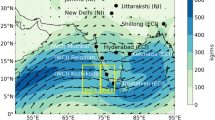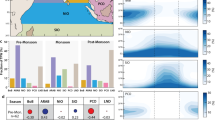Abstract
Stable oxygen isotope ratios (δ18O) of tree cellulose and speleothem carbonate are useful proxies for past monsoon rain in many tropical regions, as a decrease in rain δ18O is observed with increase in rainfall on a monthly time scale. This amount effect varies spatially; therefore a local calibration, with actual measurements of rain amount and its δ18O is required. Such observations, however, are quite limited in space and time. To circumvent this difficulty, many isotope enabled general circulation models (GCMs) are used to aid the interpretation of 18O proxies; nevertheless, all such simulations taken together are yet to be evaluated against observations over the Indian summer monsoon (ISM) region. Here we examine ten such GCM simulations archived by the stable water isotope INtercomparison Group, phase 2. The spatial patterns of simulated ISM rainfall and its δ18O are in good agreement with the limited observations available. Simulations nudged with observed wind fields show better skill in reproducing the observed spatio-temporal pattern of rainfall and its δ18O. A large discrepancy is observed in the magnitude of the simulated amount effect over the Indian subcontinent between the models and observation, probably because models simulate the spatial distribution of monsoon precipitation differently. Nudged simulations show that interannual variability of rainfall δ18O at proxy sites are controlled by either regional (rather than local) rainfall or upstream rain out. Interannual variability of rainfall δ18O over the East Asian region is well correlated with ENSO, while it is only weakly correlated over the Indian sub-continent.












Similar content being viewed by others
References
Adler RF, Huffman GJ, Chang A, Ferraro R, Xie P-P, Janowiak J, Rudolf B, Schneider U, Curtis S, Bolvin D, Gruber A, Susskind J, Arkin P, Nelkin E (2003) The version-2 global precipitation climatology project (GPCP) monthly precipitation analysis (1979–present). J Hydrometeorol 4:1147–1167. doi:10.1175/1525-7541(2003)004<1147:TVGPCP>2.0.CO;2
Araguás-Araguás L, Froehlich K, Rozanski K (2000) Deuterium and oxygen-18 isotope composition of precipitation and atmospheric moisture. Hydrol Process 14:1341–1355. doi:10.1002/1099-1085(20000615)14:8<1341:AID-HYP983>3.0.CO;2-Z
Augustin L, Barbante C, Barnes PRF, Barnola JM, Bigler M, Castellano E, Cattani O, Chappellaz J, Dahl-Jensen D, Delmonte B, Dreyfus G, Durand G, Falourd S, Fischer H, Flückiger J, Hansson ME, Huybrechts P, Jugie G, Johnsen SJ, Jouzel J, Kaufmann P, Kipfstuhl J, Lambert F, Lipenkov VY, Littot GC, Longinelli A, Lorrain R, Maggi V, Masson-Delmotte V, Miller H, Mulvaney R, Oerlemans J, Oerter H, Orombelli G, Parrenin F, Peel DA, Petit J-R, Raynaud D, Ritz C, Ruth U, Schwander J, Siegenthaler U, Souchez R, Stauffer B, Steffensen JP, Stenni B, Stocker TF, Tabacco IE, Udisti R, Van De Wal RSW, Van Den Broeke M, Weiss J, Wilhelms F, Winther J-G, Wolff EW, Zucchelli M (2004) Eight glacial cycles from an Antarctic ice core. Nature 429:623–628. doi:10.1038/nature02599
Berkelhammer M, Sinha A, Stott L, Cheng H, Pausata FSR, Yoshimura K (2012) An Abrupt Shift in the Indian Monsoon 4000 Years Ago. In: Giosan L, Fuller DQ, Nicoll K, Flad RK, Clift PD (eds) Climates, landscapes, and civilizations. American Geophysical Union, Washington, DC
Breitenbach SFM, Adkins JF, Meyer H, Marwan N, Kumar KK, Haug GH (2010) Strong influence of water vapor source dynamics on stable isotopes in precipitation observed in Southern Meghalaya, NE India. Earth Planet Sci Lett 292:212–220. doi:10.1016/j.epsl.2010.01.038
Conroy JL, Cobb KM, Noone D (2013) Comparison of precipitation isotope variability across the tropical Pacific in observations and SWING2 model simulations. J Geophys Res Atmos 118:5867–5892. doi:10.1002/jgrd.50412
Dansgaard W (1964) Stable isotopes in precipitation. Tellus 16:436–468. doi:10.1111/j.2153-3490.1964.tb00181.x
Field RD, Jones DBA, Brown DP (2010) Effects of postcondensation exchange on the isotopic composition of water in the atmosphere. J Geophys Res 115:D24305. doi:10.1029/2010JD014334
Field RD, Kim D, LeGrande AN, Worden J, Kelley M, Schmidt GA (2014) Evaluating climate model performance in the tropics with retrievals of water isotopic composition from Aura TES. Geophys Res Lett 41:6030–6036. doi:10.1002/2014GL060572
Gat JR (1996) Oxygen and hydrogen isotopes in the hydrologic cycle. Annu Rev Earth Planet Sci 24:225–262. doi:10.1146/annurev.earth.24.1.225
Gat J, Gonfiantini R (1981) Stable isotope hydrology. Deuterium and oxygen-18 in the water cycle. In: IAEA technical reports series 210, Vienna
Goswami BN, Venugopal V, Sengupta D, Madhusoodanan MS, Xavier PK (2006) Increasing trend of extreme rain events over India in a warming environment. Science 314:1442–1445. doi:10.1126/science.1132027
Hoffmann G, Heimann M (1997) Water isotope modeling in the Asian monsoon region. Quat Int 37:115–128. doi:10.1016/1040-6182(96)00004-3
Ishizaki Y, Yoshimura K, Kanae S, Kimoto M, Kurita N, Oki T (2012) Interannual variability of H 2 18 O in precipitation over the Asian monsoon region. J Geophys Res 117:1–16. doi:10.1029/2011JD015890
Jasechko S, Sharp ZD, Gibson JJ, Birks SJ, Yi Y, Fawcett PJ (2013) Terrestrial water fluxes dominated by transpiration. Nature 1–5 496:347–350. doi:10.1038/nature11983
Joussaume S, Sadourny R, Jouzel J (1984) A general circulation model of water isotope cycles in the atmosphere. Nature 311:24–29. doi:10.1038/311024a0
Kumar KK (1999) On the weakening relationship between the indian monsoon and ENSO. Science 284:2156–2159. doi:10.1126/science.284.5423.2156
Kumar KK, Rajagopalan B, Hoerling M, Bates G, Cane M (2006) Unraveling the mystery of Indian monsoon failure during El Niño. Science 314:115–119. doi:10.1126/science.1131152
Kurita N (2013) Water isotopic variability in response to mesoscale convective system over the tropical ocean. J Geophys Res Atmos 118:10,376–10390. doi:10.1002/jgrd.50754
Kurita N, Noone D, Risi C, Schmidt GA, Yamada H, Yoneyama K (2011) Intraseasonal isotopic variation associated with the Madden-Julian Oscillation. J Geophys Res 116:D24101. doi:10.1029/2010JD015209
Laskar AH, Yadava MG, Ramesh R, Polyak VJ, Asmerom Y (2013) A 4 kyr stalagmite oxygen isotopic record of the past Indian Summer Monsoon in the Andaman Islands. Geochem Geophys Geosyst 14:3555–3566. doi:10.1002/ggge.20203
Lawrence JR (2004) Stable isotopic composition of water vapor in the tropics. J Geophys Res 109:D06115. doi:10.1029/2003JD004046
Lee J-E, Fung I (2008) “Amount effect” of water isotopes and quantitative analysis of post-condensation processes. Hydrol Process 22:1–8. doi:10.1002/hyp.6637
Lee J-E, Fung I, DePaolo DJ, Henning CC (2007) Analysis of the global distribution of water isotopes using the NCAR atmospheric general circulation model. J Geophys Res 112:D16306. doi:10.1029/2006JD007657
Lee J-E, Pierrehumbert R, Swann A, Lintner BR (2009) Sensitivity of stable water isotopic values to convective parameterization schemes. Geophys Res Lett 36:L23801. doi:10.1029/2009GL040880
Lee J-E, Risi C, Fung I, Worden J, Scheepmaker RA, Lintner B, Frankenberg C (2012) Asian monsoon hydrometeorology from TES and SCIAMACHY water vapor isotope measurements and LMDZ simulations: implications for speleothem climate record interpretation. J Geophys Res 117:D15112. doi:10.1029/2011JD017133
Lekshmy PR, Midhun M, Ramesh R, Jani RA (2013) Is the Isotopic Composition of Rainfall of the South west coast of India Independent of Local Rainfall Amount? In: 12th ISMAS Triennial international conference on mass spectrometry, pp 306–308
Lekshmy PR, Midhun M, Ramesh R, Jani RA (2014) 18O depletion in monsoon rain relates to large scale organized convection rather than the amount of rainfall. Sci Rep 4:5661. doi:10.1038/srep05661
Mathieu R, Pollard D, Cole JE, White JWC, Webb RS, Thompson SL (2002) Simulation of stable water isotope variations by the GENESIS GCM for modern conditions. J Geophys Res 107:4037. doi:10.1029/2001JD900255
Midhun M, Lekshmy PR, Ramesh R (2013) Hydrogen and oxygen isotopic compositions of water vapor over the Bay of Bengal during monsoon. Geophys Res Lett 40:6324–6328. doi:10.1002/2013GL058181
Moore M, Kuang Z, Blossey PN (2014) A moisture budget perspective of the amount effect. Geophys Res Lett 41:1329–1335. doi:10.1002/2013GL058302
Nanjundiah RS, Vidyunmala V, Srinivasan J (2005) On the difference in the seasonal cycle of rainfall over India in the Community Climate System Model (CCSM2) and Community Atmospheric Model (CAM2). Geophys Res Lett 32:1–3. doi:10.1029/2005GL024278
Noone D, Sturm C (2010) Comprehensive dynamical models of global and regional water isotope distributions. In: Isoscapes. Springer, pp 195–219
Ramesh R, Tiwari M, Chakraborty S, Managave SR, Yadava MG, Sinha DK (2010) Retrieval of south Asian monsoon variation during the Holocene from natural climate archives. Curr Sci 99:1770–1786
Risi C, Bony S, Vimeux F (2008) Influence of convective processes on the isotopic composition (δ18O and δD) of precipitation and water vapor in the tropics: 2. Physical interpretation of the amount effect. J Geophys Res 113:D19306. doi:10.1029/2008JD009943
Risi C, Bony S, Vimeux F, Chong M, Descroix L (2010a) Evolution of the stable water isotopic composition of the rain sampled along Sahelian squall lines. Q J R Meteorol Soc 136:227–242. doi:10.1002/qj.485
Risi C, Bony S, Vimeux F, Jouzel J (2010b) Water-stable isotopes in the LMDZ4 general circulation model: model evaluation for present-day and past climates and applications to climatic interpretations of tropical isotopic records. J Geophys Res Atmos 115:1–27. doi:10.1029/2009JD013255
Risi C, Noone D, Worden J, Frankenberg C, Stiller G, Kiefer M, Funke B, Walker K, Bernath P, Schneider M, Wunch D, Sherlock V, Deutscher N, Griffith D, Wennberg PO, Strong K, Smale D, Mahieu E, Barthlott S, Hase F, García O, Notholt J, Warneke T, Toon G, Sayres D, Bony S, Lee J, Brown D, Uemura R, Sturm C (2012) Process-evaluation of tropospheric humidity simulated by general circulation models using water vapor isotopologues: 1. Comparison between models and observations. J Geophys Res 117:1–26. doi:10.1029/2011JD016621
Sabin TP, Krishnan R, Ghattas J, Denvil S, Dufresne J-L, Hourdin F, Pascal T (2013) High resolution simulation of the South Asian monsoon using a variable resolution global climate model. Clim Dyn 41:173–194. doi:10.1007/s00382-012-1658-8
Schmidt GA, LeGrande AN, Hoffmann G (2007) Water isotope expressions of intrinsic and forced variability in a coupled ocean-atmosphere model. J Geophys Res 112:D10103. doi:10.1029/2006JD007781
Sime LC, Wolff EW, Oliver KIC, Tindall JC (2009) Evidence for warmer interglacials in East Antarctic ice cores. Nature 462:342–345. doi:10.1038/nature08564
Sinha A, Cannariato KG, Stott LD, Cheng H, Edwards RL, Yadava MG, Ramesh R, Singh IB (2007) A 900-year (600 to 1500 A.D.) record of the Indian summer monsoon precipitation from the core monsoon zone of India. Geophys Res Lett. doi:10.1029/2007GL030431
Taylor KE (2001) Summarizing multiple aspects of model performance in a single diagram. J Geophys Res 106:7183. doi:10.1029/2000JD900719
Vuille M, Werner M, Bradley RS, Keimig F (2005) Stable isotopes in precipitation in the Asian monsoon region. J Geophys Res 110:1–15. doi:10.1029/2005JD006022
Xie P, Arkin PA (1997) Global precipitation: a 17-year monthly analysis based on gauge observations, satellite estimates, and numerical model outputs. Bull Am Meteorol Soc 78:2539–2558. doi:10.1175/1520-0477(1997)078<2539:GPAYMA>2.0.CO;2
Yadava MG, Ramesh R (2005) Monsoon reconstruction from radiocarbon dated tropical Indian speleothems. Holocene 15:48–59. doi:10.1191/0959683605h1783rp
Yadava M, Ramesh R, Pandarinath K (2007) A positive “amount effect” in the Sahayadri (Western Ghats) rainfall. Curr Sci 93:560–564
Yoshimura K, Kanamitsu M, Noone D, Oki T (2008) Historical isotope simulation using Reanalysis atmospheric data. J Geophys Res 113:D19108. doi:10.1029/2008JD010074
Yurtsever Y, Gat JR (1981) Atmospheric waters. In: Gat J, Gonfiantini R (eds) Stable isotope hydrology: deuterium and oxygen-18 in the water cycle. IAEA technical reports series 210, pp 103–142
Acknowledgments
We acknowledge the contributors to SWING2 project. We thank two anonymous reviewers, whose comments considerably improved the manuscript. We thank ISRO-GBP for funding.
Author information
Authors and Affiliations
Corresponding author
Electronic supplementary material
Below is the link to the electronic supplementary material.
Rights and permissions
About this article
Cite this article
Midhun, M., Ramesh, R. Validation of δ18O as a proxy for past monsoon rain by multi-GCM simulations. Clim Dyn 46, 1371–1385 (2016). https://doi.org/10.1007/s00382-015-2652-8
Received:
Accepted:
Published:
Issue Date:
DOI: https://doi.org/10.1007/s00382-015-2652-8




